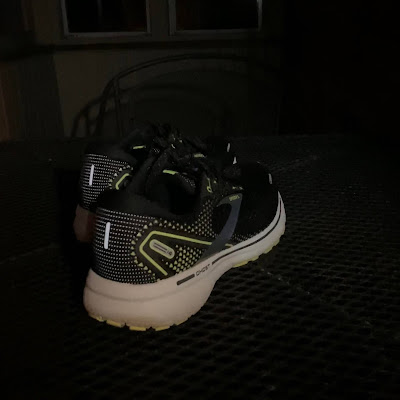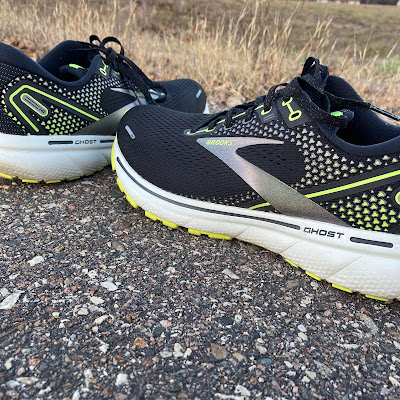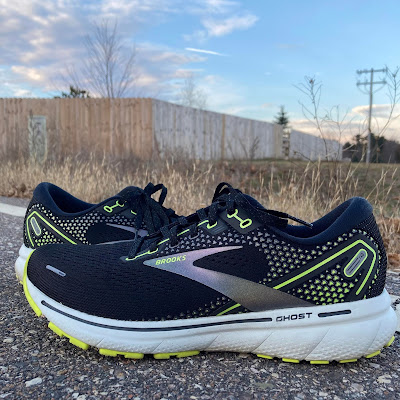Brooks Ghost 14 Review
By Senior Contributor Nathan Brown PT, DPT, OCS
It has been a long while since we have taken a look at the Brooks Ghost. In fact, the last reviewed Ghost was the Ghost 6, all the way back when our founder was a student physical therapist. The Ghost has been, and continues to be, a very popular shoe among the running and non-running community. This review will look at Brook's design decisions and how they had more than just the beginner runner in mind when creating this shoe.
 |
| Pair of Run Visible Brooks Ghost 14 in black with yellow graphics. |
$129.95 at Running Warehouse
Weight: 10.0 oz/283.5 g (men's size 9); 8.8 oz/249.5 g (women's size 8)
Stack Height: 36mm (heel), 24mm (forefoot)
Drop: 12mm
Classification: daily trainer
BROOKS GHOST 14 SUMMARY
The Brooks Ghost 14 is a moderately firm yet cushioned trainer that is overall simplistic in its design. The overall construction and running experience is traditional and unremarkable in terms of midsole rebound feel or propulsion due to a flatter geometry. This lends the Ghost 14 to be an option as a traditional daily trainer (solid option for a new runner), a walking shoe, a shoe that you will use for a job that you're on your feet for a long time and want lasting comfort.
BROOK GHOST 14'S FIT
The 14's fit me true to size in my men's size 9 and is consistent with other Brooks shoes in terms of fit. Moving from back to front, there is not much variability between the different regions, but has a flatter construction. This means that the heel, midfoot, and toe box are all moderate in width without significant variation, whereas in other shoes you may see a moderate to narrow heel, a snug and secure midfoot, and then a more open toe box. The heel is padded and overall comfortable, but never fully locked down, particularly when picking up the pace. Part of the heel slippage is likely due to the moderate width in the midfoot and lack of lacing system that really can anchor the midfoot. Again, this was fine for daily use, but in moving more quickly I did have some translation of the foot in the midfoot and this contributed to the lack of full lock down in the heel. Finally the toe box has a really nice balance to it. There is a soft toe guard that holds the shape and vamp of the toe box without irritating the toes and there is ample volume for the foot without being sloppy. From an upper security standpoint, the Ghost does everything needed for daily running and is one of those uppers that disappears on foot.
The engineered mesh upper feels lightweight but is thick enough for the colder months here in Wisconsin. I also have the Run Visible edition, which has some reflective detailing on the padded tongue and midfoot that add a bit of rigidity, though none of it is abrasive in any way. I'll go more into the effectiveness of the Run Visible features next.
 |
| Sample of Brooks Ghost 14 Run Visible tech in the dark |
RUN VISIBLE
The days in Wisconsin are getting remarkably short, which means a lot of runs in the dark. And not just some "dark-ish" runs where the city lights give some hue to see with. I mean dark. Black. Rural WI isn't messing around. That's why utilizing lights and clothing to stay visible is vitally important (literally).
Brooks has an entire Run Visible collection of clothing, and part of this is the footwear with additional reflective detailing. The main question I want to answer is, "are these shoes sufficient to be visible at night/early morning?" In a word, no. There are three strips of reflective material that are highly reflective: one on the heel and then two that are on each side of the toe box. These areas are highly reflective and one is visible from every angle of the shoe, but they are rather small. Beyond those three strips, there are less reflective detailing including the Brooks logo, overlays, the tongue, and even the laces. However, these are less reflective. In the end, please do not use this as your only mode of being visible at night. They certainly won't hurt your overall visibility, but they are not sufficient to keep you safest at night.
PERFORMANCE
Brooks gave the Ghost 14 a full DNA LOFT midsole. Seeing as we haven't tested a Ghost in a long time, I can't give comparisons to previous iterations, but DNA LOFT sits in the midpoint between soft and firm, if not verging toward the firmer end of the spectrum. Despite its firmness, there is plenty of foam underneath in the heel and felt cushioned over longer runs. There is a 12mm drop, and it seems to run consistent with that number given the firmer foam and thicker later of durable outsole rubber (which provides fairly good traction).
Ultimately the ride of this shoe is consistent from heel to toe, and has what I would call an "airy" ride. It isn't plush or soft, but the DNA LOFT cushioning feels really light on the run and strides feel light and cushioned. The higher drop does lead to a noticeable initial contact, but not abrasive like other high drop shoes can be. Transitions from heel to toe are smooth, and the forefoot is flexible to give a natural toe off feel. The transition also feels faster than expected, which may be related to the 12mm drop and falling quickly from the high heel to lower forefoot. This did allow me to do fine with very mild tempo work and strides in the shoe (though it was best for easy/daily mileage). Given the 12mm drop, the heel feels much more "protective" than the forefoot, where by the end of longer runs I could notice increased pressure through the balls of my feet (metatarsal heads). For those who are used to running in higher drop shoes, you won't have a problem. For those who are sensitive to higher drops or have metatarsal issues, I would recommend trying the shoe on before purchasing.
A final note on DNA LOFT foam. I found that even over the first 1-2 runs the platform of the DNA LOFT seemed to have an imprint of my foot. This meant that I started to feel some increased pressure under the arch of my foot, but nothing problematic. This could be helpful for those who like a little more support under the midfoot, while possibly being irritating for those who don't.
A quick word on other uses. I have worn this shoe for work for many days, and it really does function well for standing and walking around. At times, too soft a midsole can lead to fatigue due to the foot stabilizing itself on the platform and too firm a midsole can be uncomfortable. Having the Ghost land in the middle was a nice level of cushioning for the workplace.
STABILITY
The Ghost 14 is in every sense of the word a neutral running shoe. The platform and ground contact is full, but narrows a bit through the midfoot. Additionally, the upper is not snug or supportive to the foot in any particular way, so no additional stability I gained that way. The moderately firmer foam and full contact outsole (with segmented crash pad) does create some natural stability, but nothing to place this shoe anywhere above neutral.
THOUGHTS AS A DPT / FOOTWEAR SCIENCE
On the Versatility of the Brooks Ghost 14, Outside of Running
When we speak about versatility, we are typically thinking about how a shoe performs at daily paces, tempo paces, workout paces, recovery paces, etc. The Ghost 14 is versatile, but not in that sense. It finds its versatility in that it has a construction that is suited well for activities beyond running alone. We live in a world where it's no longer safe to say that "if you want a good walking shoe, just find a good running shoe". Let's look at a few quick examples:
Exhibit A: Adidas Adizero Adios Pro 2
The Adios Pro 2 is arguably one of the "best" marathon racing shoes this year (2021) with the high stack, rockered geometry, supercritical foam, etc. It also has created a niche in the supershoe market with the lateral bias present via the bevel, lateral slice in the midsole, and medial cutout. When this shoe is running and at pace, it also is relatively stable, providing a platform that guides a runner from lateral to medial as you transition forward. However, just standing or walking in this shoe is quite unpleasant. For some it can feel like you are falling off the outside of the shoe, you can feel the cutout on the medial side, and the foam sinks in the heel and to the outside. This leads to a standing posture where pressure is focused to the outside and back of the shoe (foot in dorsiflexion and inversion and supination). What's going on here?
Exhibit B: Saucony Endorphin Speed 2
The Endorphin Speed and Speed 2 are possibly the most popular running shoes of the last couple of years. Despite their popularity for running, they also aren't a wonderful feel for walking and standing. Again, this shoe contains a supercritical foam (PWRUN PB), has a narrow midfoot contact with the ground, and functions off of a stiffer forefoot rocker geometry. The sensation of standing and walking is not as starkly uncomfortable as it is in the Adios Pro 2, but it feels "unnatural" to spend a lot of time in one place or walking at casual paces.
Exhibit C: Brooks Ghost 14
The Brooks Ghost 14 stands apart from the previous examples in that it uses a more traditional EVA midsole, has a wider and full contact with the ground, has a flexible forefoot, and doesn't operate off of a rocker sole.
Why does a foot posture within a shoe change in standing vs walking vs running? And why do some of the "best" running shoes no longer work for walking and standing? Well, walking and running require very different mechanics, and the amount of time spent on different parts of a shoe lead to the difference in foam compression or deformation. The Adios Pro 2 is built to have you quickly transition over the heel and midfoot. Once up and running quickly, the amount of deformation through the heel and bevel is less severe as you transition over the surface of the shoe instead of sinking into different aspects of the shoe design.
Think of it like a boat moving over waves in Lake Michigan. If you go slowly over some 3-5 ft rolling waves, you're going to feel every single wave. However, once your boat is on a plane, you don't feel those smaller waves anymore. In a sense, this is what is happening with some of these newly constructed running shoes.
The Brooks Ghost 14 has a construction that suits any scenario (walking, standing, running) well. Much of this can be contributed to two things: geometry and foam. The geometry is not rockered, which means that it is easy to find a balance point and you do not need to stabilize yourself when in a stationary position. It also has flexibility, which means that any forefoot rocker that is present is able to flex with loading and mold to the surface below. The foam is also flatter (not responsive) and firmer yet cushioned. When walking, we don't operate through propulsive forces the way we do in running. Therefore, a highly responsive/bouncy foam can create a "mismatch" between the goal of walking and what the foam is trying to do. A simple foam goes a long way in a walking shoe.
All this said, there are rocker sole shoes that function really well as walking shoes, but that's a discussion for another time. We are working on a walking shoe guide as I write this, so we will update this review with that link as we finish it up.
RECOMMENDATIONS
The Ghost sits in a category of shoes that is needed: those that are high quality materials that can do more than just run. I'd recommend continuing this pursuit, as not all shoes do this anymore. Although a major change, I would consider altering the drop and adding a few mm of stack to the forefoot. I think this could keep consistent "protective" sensation between the heel and forefoot while also making the heel to toe transition more moderate for people with sensitive metatarsals (knowing that you'd be trading away benefits of higher drop).
WHO THE BROOKS GHOST 14 IS FOR
The Brooks Ghost 14 is a shoe that will suit a number of runners looking for a traditional, consistent, and flatter ride. It is best for those who not only want to run, but also are walkers and need a shoe for lots of standing activities, whether at work or for a hobby around the home. It can handle many miles and moderate to longer distance runs, and is best for people who do not have any needs for stability.
GRADING
Nathan
Fit: B (Upper feels nice, just lacking some contours to really secure the midfoot and heel)
Performance: B+ (Higher grade for the versatility for various activities and the lightweight feel of the shoe. As a pure running shoe, probably a B given the heel toe quick transition and increased pressure felt on forefoot)
Stability: B (True neutral shoe, quick transition may give some people issues who have forefoot instability)
DPT/Footwear Science: A (I know that Brooks consciously has other consumers other than runners in mind, and that's a really good thing)
Personal: B (A little flat for my liking when it comes to daily running, but I do really enjoy it for work and playing with the kiddos)
Overall: B
SHOP | SUPPORT DOR
Find the Brooks Ghost 14 at Running Warehouse here. Using the link to purchase helps support Doctors of Running. Thanks so much!
Check out Gear We Love
Adidas Boston 10: Our daily trainer favorite of 2021
Asics Metaspeed Sky: Chief Editor Matt Klein can't stop racing in it, even on trails (not advised)
Hoka Arahi 5: One of the best stability shoes of the year, and the best walking shoe as well. Versatile.
Feetures Socks: Massively grippy socks that will make you feel more one with the shoe
Huma Chia Gel: Natural and goes down easy. Powered Contributor Nathan Brown to his marathon
Trigger Point Foam Roller: Help get those knots out post-run and feel better for tomorrow
Theragun Massager: This small version is great on the go for working tired legs
Ciele Hat: Our team's favorite running hat of choice!
FURTHER READING
Compare Daily Trainers
Topo Ultrafly 3 - A solid do-it-all in the same vein as the Ghost 14, but on the opposite end with zero drop
Mizuno Wave Rider 25 - A flexible forefoot offers a different ride upfront while a wave plate makes this one of the most stable neutral trainers of the year
Adidas Boston 10 - Our trainer of the year. Once broken in, a versatile show for doing everything from workouts to long runs
Recently at Doctors of Running
Best Daily Trainer of 2021, DPT Approved
adidas Terrex Agravic Ultra - A super durable trail trainer for long distances.
Asics DS Trainer 26 - The classic stability workout trainer continues on
Find all Shoe Reviews at Doctors of Running here.
Thanks for reading!
Strava: Doctors of Running
Podcast: Virtual Roundtable
Pinterest: Doctors of Running
TESTER PROFILES:
Movement Performance Institute Certified in Advanced Functional Biomechanics
Dr. Brown is a 155 lb male with notable PRs of 18:18 5K, 39:25 10K, 1:29:01 half marathon, and 3:54 marathon. He typically runs between 20-50 miles per week at a variety of paces from 8:00-9:00 min/mile for recovery runs to 6:45-7:15 min/mile for tempo runs. He typically prefers shoes that provide some cushioning underfoot but still maintain a more firm and responsive feel.
Editor's Note: As always, the views presented on this website belong to myself or the selected few who contribute to these posts. This website should not and does not serve as a replacement for seeking medical care. If you are currently injured or concerned about an injury, please see your local running physical therapist. If you are in the Los Angeles area, I am currently taking clients for running evaluations.
Contact us at doctorsofrunning@gmail.com
NEXT: Best Daily Trainer of 2021, DPT Approved









